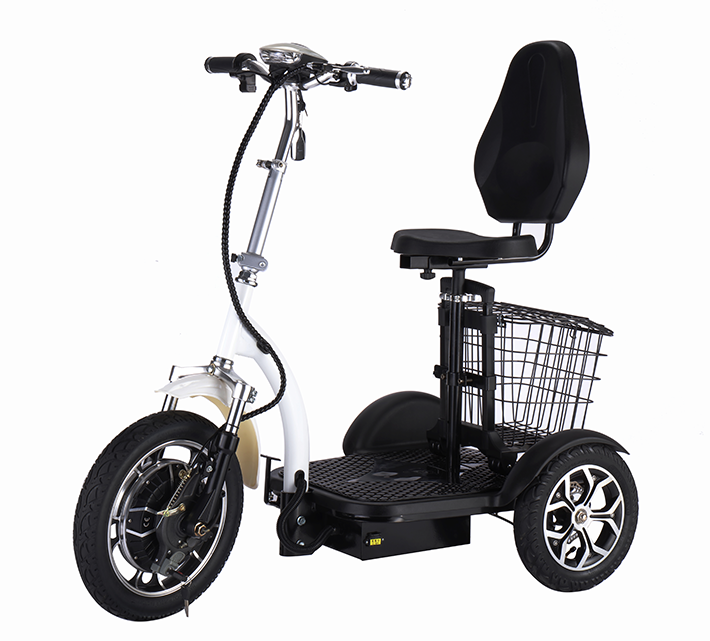Comparing Smart and Traditional Mobility Scooters
1. Behind the Market Divergence: The Core Positioning of the Two Types of Mobility Scooters
At the Guangzhou Older Vehicles Expo, smart and traditional mobility scooters presented a “dual track” market:
Smart scooters: Positioned as “quality mobility,” they feature features like obstacle sensing and health monitoring, priced between 10,000 and 30,000 yuan, targeting high-end consumers who prioritize safety and convenience;
Traditional scooters: Emphasizing “pragmatism,” they offer only forward/reverse/pause buttons, priced between 3,000 and 8,000 yuan, becoming the primary choice for daily short-distance travel, accounting for over 70% of sales.
This differentiation is also evident in the export market: European and American buyers prefer the safety features of smart scooters, while Southeast Asian buyers prefer the cost-effectiveness of traditional scooters.
Second and Third Dimensions of Hardcore Comparison: From Configuration to Cost

1. Core Functions and Safety Performance
Dimensions
Smart Mobility Scooter
Traditional Mobility Scooter
Operational Design
Joystick + Touchscreen, Voice Control Support (e.g., chairlift)
Mechanical Buttons, Only 3-5 Operational Buttons
Safety Features
Automatic Obstacle Avoidance, Rollover Mitigation, Electromagnetic Braking, Tire Pressure Monitoring
Basic Braking System, Some with Rearview Mirrors
Health Features
Heart Rate/Blood Pressure Monitoring, Emergency Calling with Family Members
No Related Features
Cruise Range
80-150 km (Lithium Battery)
20-60 km (Lead-Acid Battery)
Key Note: ABS (US) and Rollover Protection (EU) are mandatory requirements in the European and American markets, and smart models are more likely to meet these requirements.
2. Cost Structure and Operating Costs
Purchase Cost: Smart models are 50%-200% higher than traditional models of the same level. The core price difference comes from the lithium battery (which costs three times more) and the smart controller (1,500 yuan vs. 500 yuan).
Operation Cost: The average annual electricity bill for a smart model is approximately 300 yuan, while for a traditional model it’s approximately 200 yuan. However, the battery in a traditional model requires more frequent replacement (2 years vs. 5 years).
Maintenance Cost: The sensor repair cost for a smart model is approximately 800 yuan per repair, while the mechanical components of a traditional model only cost 200 yuan.
3. Differences in Export Compliance
Market
Advantages of Smart Adaptation
Risks of Traditional Compliance
EU
Easy to pass e-mark certification, meets rollover protection standards
Most models do not meet the 125mm roof deformation requirement
US
Standard ABS, meets 27 NHTSA safety requirements
46 states have varying regulations, some prohibiting driving on major roads
India
Can pass the CMVR crash test
Most models are in a regulatory gray area
III. Scenario-Based Purchasing Decision Guide
1. Matching Models to Needs
✅ 3 Scenarios for Smart Models:
① Buyer aged 75+ or with mobility issues (requiring assisted entry and exit);
② Exporting to highly regulated markets such as Europe and the United States (requiring safety certification);
③ Focusing on health monitoring and remote care (e.g., families with children residing overseas). ✅ 3 Situations for Choosing a Traditional Model:
① Budget under 8,000 RMB, primarily for basic commuting;
② Exporting to emerging markets such as Southeast Asia and Africa;
③ For use in confined areas (such as markets and residential areas), requiring a lightweight body (<50kg).
2. 3 Key Export Checks
Certification Compatibility: The EU requires e-mark, India requires dual CMVR and BIS certification, and the certification pass rate for smart models exceeds 90%;
Range Compatibility: For the Nordic market, a range of 100km+ is preferred (reduced by 30% in winter); for tropical markets, battery heat resistance is a priority;
After-Sales Service: Smart models must provide remote diagnostic services, and traditional models must ensure global availability of wearing parts (such as brake pads).
IV. Real-World Case Study: Overseas Deployment of Two Model Types
European Family Scenario: A German customer purchased a customized smart model from Mercedes-Benz, emphasizing automatic obstacle avoidance and ISO 3471 rollover test certification for daily suburban commuting.
Southeast Asian Merchant Scenario: A Thai vegetable market vendor chose a traditional Yadi model, budgeting 5,000 yuan to cover a 20km daily delivery. The vehicle’s narrow width of 0.8m facilitates easy maneuvering.
Post time: Oct-17-2025


